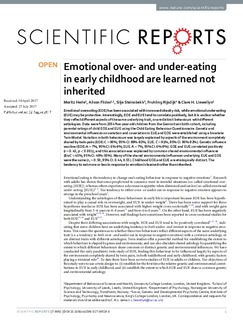Emotional over- and under-eating in early childhood are learned not inherited
| dc.contributor.author | Herle, Moritz | |
| dc.contributor.author | Fildes, Alison | |
| dc.contributor.author | Steinsbekk, Silje | |
| dc.contributor.author | Rijsdijk, Frühling | |
| dc.contributor.author | Llewellyn, Clare H | |
| dc.date.accessioned | 2018-08-22T11:07:53Z | |
| dc.date.available | 2018-08-22T11:07:53Z | |
| dc.date.created | 2018-01-09T14:43:43Z | |
| dc.date.issued | 2017 | |
| dc.identifier.issn | 2045-2322 | |
| dc.identifier.uri | http://hdl.handle.net/11250/2558824 | |
| dc.description.abstract | Emotional overeating (EOE) has been associated with increased obesity risk, while emotional undereating (EUE) may be protective. Interestingly, EOE and EUE tend to correlate positively, but it is unclear whether they reflect different aspects of the same underlying trait, or are distinct behaviours with different aetiologies. Data were from 2054 five-year-old children from the Gemini twin birth cohort, including parental ratings of child EOE and EUE using the Child Eating Behaviour Questionnaire. Genetic and environmental influences on variation and covariation in EUE and EOE were established using a bivariate Twin Model. Variation in both behaviours was largely explained by aspects of the environment completely shared by twin pairs (EOE: C = 90%, 95% CI: 89%-92%; EUE: C = 91%, 95% CI: 90%-92%). Genetic influence was low (EOE: A = 7%, 95% CI: 6%-9%; EUE: A = 7%, 95% CI: 6%-9%). EOE and EUE correlated positively (r = 0.43, p < 0.001), and this association was explained by common shared environmental influences (BivC = 45%, 95% CI: 40%-50%). Many of the shared environmental influences underlying EUE and EOE were the same (rC = 0.50, 95% CI: 0.44, 0.55). Childhood EOE and EUE are etiologically distinct. The tendency to eat more or less in response to emotion is learned rather than inherited. | nb_NO |
| dc.language.iso | eng | nb_NO |
| dc.publisher | Nature Publishing Group | nb_NO |
| dc.rights | Navngivelse 4.0 Internasjonal | * |
| dc.rights.uri | http://creativecommons.org/licenses/by/4.0/deed.no | * |
| dc.title | Emotional over- and under-eating in early childhood are learned not inherited | nb_NO |
| dc.type | Journal article | nb_NO |
| dc.type | Peer reviewed | nb_NO |
| dc.description.version | publishedVersion | nb_NO |
| dc.source.volume | 7 | nb_NO |
| dc.source.journal | Scientific Reports | nb_NO |
| dc.source.issue | 1 | nb_NO |
| dc.identifier.doi | 10.1038/s41598-017-09519-0 | |
| dc.identifier.cristin | 1538986 | |
| dc.description.localcode | © The Author(s) 2017. This article is licensed under a Creative Commons Attribution 4.0 International License. | nb_NO |
| cristin.unitcode | 194,67,40,0 | |
| cristin.unitname | Institutt for psykologi | |
| cristin.ispublished | true | |
| cristin.fulltext | original | |
| cristin.qualitycode | 1 |
Tilhørende fil(er)
Denne innførselen finnes i følgende samling(er)
-
Institutt for psykologi [2886]
-
Publikasjoner fra CRIStin - NTNU [37221]

